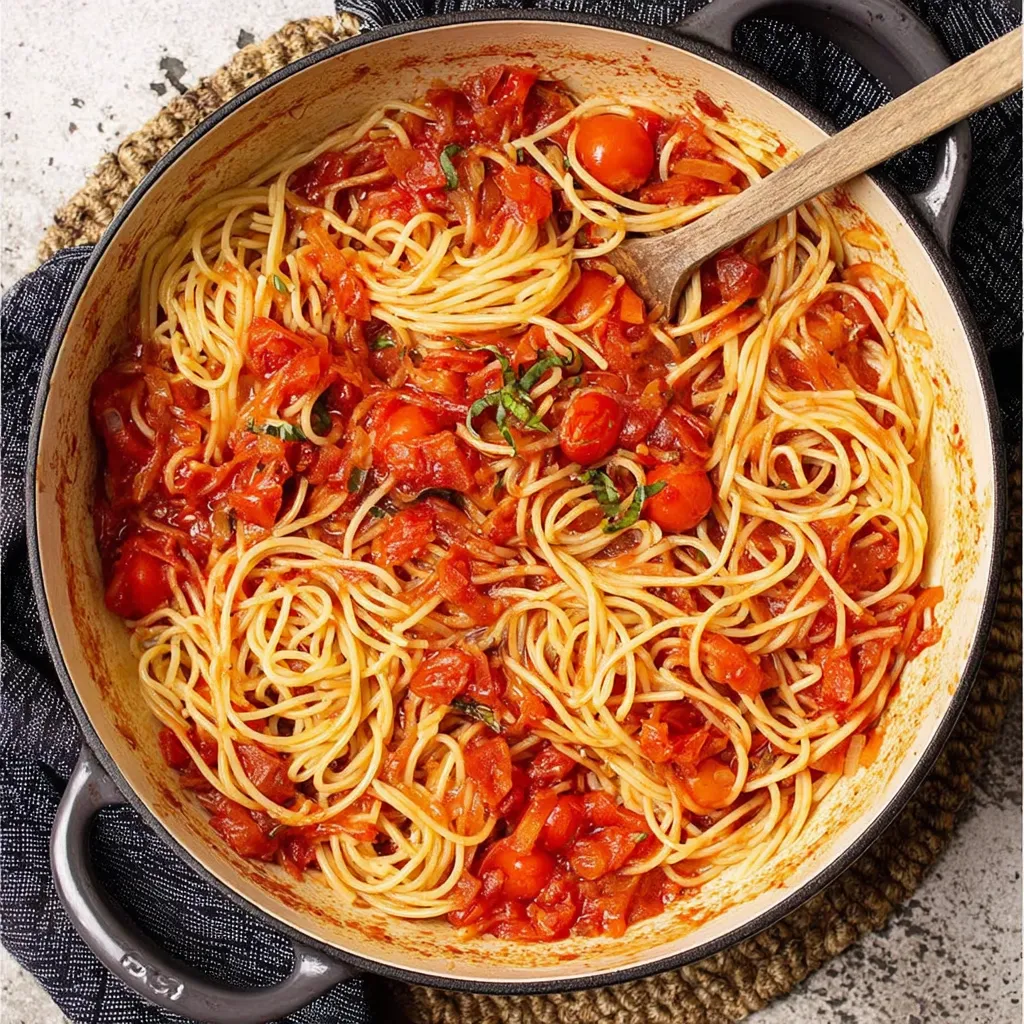 Save
Save
This tomato basil pasta has become my weeknight dinner hero, rescuing me countless times when I need something delicious and satisfying without spending hours in the kitchen. The fresh flavors of tomato and basil combine with the comforting embrace of pasta to create a dish that feels both indulgent and wholesome.
I first made this recipe during a particularly hectic week when I needed something quick yet satisfying. What started as a simple solution to a busy evening has evolved into one of my family's most requested meals, especially when fresh basil is abundant in my garden.
Ingredients
- Olive oil: Brings a fruity foundation to the sauce that enhances all other flavors
- Yellow onion: Adds sweetness when cooked down properly; look for firm onions with no soft spots
- Garlic cloves: Provide essential aromatic depth; fresh is significantly better than pre-minced
- Canned diced tomatoes: Create the backbone of the sauce; select San Marzano for best flavor
- Balsamic vinegar: Introduces a subtle sweetness and complexity; aged balsamic makes a noticeable difference
- Pasta water: Contains starches that help the sauce cling to the pasta; always reserve some before draining
- Thin spaghetti or angel hair: Cooks quickly and pairs perfectly with the light sauce
- Fresh basil: Brings the signature fresh aroma and flavor that defines this dish
- Parmesan cheese: Adds savory depth and creaminess; choose authentic Parmigiano Reggiano when possible
Step-by-Step Instructions
- Cook the Pasta:
- Bring a large pot of heavily salted water to a rolling boil before adding pasta. Cook according to package directions until al dente; typically 6 to 8 minutes depending on the thickness. Be sure to reserve at least 1 cup of the starchy cooking water before draining.
- Sauté the Aromatics:
- Heat olive oil in a large pan over medium-low heat until it shimmers but doesn't smoke. Add the diced onions, garlic, and seasonings, cooking gently for 5 minutes until they become translucent and fragrant. This slow cooking process creates a sweet foundation without any bitterness.
- Build the Sauce:
- Add the drained diced tomatoes and balsamic vinegar to the pan, stirring to combine with the aromatics. Allow this mixture to simmer for 5 to 8 minutes until it reduces slightly and the flavors meld together. The tomatoes should maintain some texture while creating a light sauce.
- Combine and Finish:
- When pasta is perfectly cooked, add half a cup of the reserved pasta water to the tomato mixture, creating a silky consistency. Add drained pasta, fresh basil, and grated parmesan to the pan, tossing everything together until the pasta is fully coated and the cheese begins to melt into the sauce.
The most transformative element in this recipe is undoubtedly the fresh basil. I grow several varieties in my garden, but sweet Genovese basil works particularly well here. During one memorable dinner party, a friend who claimed to dislike pasta dishes had three servings and asked for the recipe before leaving.
Making It Ahead
While this pasta is best enjoyed immediately after preparation, you can prepare components in advance to streamline the cooking process. The tomato sauce can be made up to two days ahead and stored in the refrigerator. When ready to serve, simply reheat the sauce, add fresh pasta water, and continue with the final steps. This approach maintains the bright flavors while saving precious minutes during dinner preparation.
Seasonal Variations
During summer months, when tomatoes are at their peak, consider substituting the canned tomatoes with 2 pounds of fresh ripe tomatoes. Simply blanch, peel, seed, and chop them before adding to the recipe. The fresh tomatoes create a lighter, brighter flavor profile that showcases summer produce beautifully. In winter, the canned version provides consistent quality and comfort when fresh produce is less available.
Serving Suggestions
This pasta shines as a standalone dish but pairs wonderfully with a simple arugula salad dressed with lemon and olive oil. For a more substantial meal, add grilled chicken breast or sautéed shrimp to introduce protein. A glass of Chianti or Pinot Grigio complements the flavors perfectly, creating a restaurant-worthy experience at home. For special occasions, consider adding burrata cheese on top just before serving.
 Save
Save
Recipe FAQs
- → Can I use fresh tomatoes instead of canned?
Yes! Fresh tomatoes work beautifully in this dish. Use about 6-8 medium tomatoes, diced. If they're not very juicy, you might want to add a tablespoon of tomato paste to enhance the flavor. The cooking time may need to be adjusted slightly to allow fresh tomatoes to break down.
- → How can I make this dish more substantial?
To make this a heartier meal, consider adding protein like grilled chicken, shrimp, or Italian sausage. You could also incorporate vegetables such as zucchini, bell peppers, or spinach. For a creamier variation, stir in a few tablespoons of heavy cream or mascarpone cheese just before serving.
- → Can I make this ahead of time?
While best enjoyed fresh, you can prepare the tomato sauce up to 2 days ahead and refrigerate it. Cook the pasta just before serving, then combine with the reheated sauce, fresh basil, and cheese. You may need to add a splash of pasta water or olive oil to refresh the sauce.
- → What can I do with the drained tomato juice?
The drained tomato juice is perfect for adding to soups, stews, or risotto for extra flavor. You can also use it as part of a marinade, mix it into a Bloody Mary, or reduce it on the stove with herbs to create a simple sauce for another dish.
- → What's the best type of pasta to use?
Thin spaghetti or angel hair pasta works best as specified in the instructions because the light, delicate strands complement the fresh tomato sauce. However, you could substitute with linguine, fettuccine, or even penne if that's what you have on hand. Just be aware that thicker pasta shapes may require more sauce to coat properly.
- → Why is pasta water important in this dish?
Pasta water contains starch released from the pasta during cooking. When added to the sauce, this starchy water helps create a silky texture that allows the sauce to cling to the pasta. It also helps to adjust the consistency of the final dish without diluting the flavor, as plain water would.
